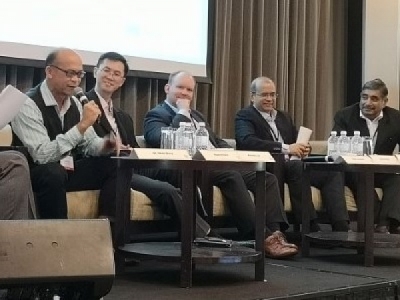
Posted on November 26, 2018
The inaugural Maritime Digital Innovation Summit took place in Singapore on 14 and 15 November with speakers and delegates from Singapore, southeast Asia and further afield coming together to discuss pressing issues related to digitalisation in the maritime sector.
A range of topics were covered but strong trends throughout the two-day conference were cyber risk, additive manufacturing, autonomous shipping and how to increase the uptake of digital solutions. Singapore Solutions was in attendance and in this first of two articles on the conference, we pick out key takeaways from the first day.
The first day kicked off with Association of Singapore Marine Industries (ASMI) president Abu Bakar Mohd Nor delivering the opening address. Noting the length of the downturn in the industry, Mr Bakar said “While we see positive signs, we cannot just rely on business as usual.
“Industry must seize more opportunities, especially in the area of innovation and capability improvement.”
He gave details of the Industry Transformation Programme being implemented by Singapore’s Ministry of Trade and Industry, which seeks to strengthen 23 key sectors of the country’s economy through setting out roadmaps known as ITMs for innovation and transformation and deepening partnerships between the public sector, government and industry. The maritime ITM is led by the Maritime and Port Authority of Singapore, while there is also a marine and offshore engineering ITM being led by ASMI. “The whole idea is to achieve global leadership in smart marine and offshore engineering solutions,” Mr Bakar explained.
OSM Maritime Group chief technology officer Chakib Abi-Saab addressed what he sees as the elephant in the room when it comes to digitalisation. He said “One of the biggest challenges we face is that many technology leaders fail to understand the business side of their organisation.
“We go to the board of directors and the chief executive and we talk about technology: we talk about speed, we talk about backups.
“We do not talk about the bottom line, we do not talk about competitive advantages, and until we change that and start addressing technology in business terms that make sense for the business, we will not move forward.
“The maritime industry is a business, this is not an area where we allow technology because it’s cool,” he said.
Bureau Veritas’ global technology leader for smart ships Najmeh Masoudi presented the view from class on cyber security and smart shipping.
Ms Masoudi gave updates on smart shipping projects BV is currently involved in and cyber services it provides as well as opining on trends within the sector and offering advice on cyber security. She highlighted that cyber can be broken down into three interacting areas: cyber security, aimed at preventing intentional malicious actions; cyber safety, aimed at preventing accidents and mistakes; and cyber performance, which is aimed at measuring and improving health and performance through data use.
The morning closed with a panel discussion on increasing adoption of digital solutions between Group Nautical managing director Bhupesh Gandhi, Maritime Port Authority of Singapore director Kenneth Lim, Association of Marine Industries Malaysia honorary secretary Nazery Khalid, Rolls-Royce senior vice-president for concepts and innovation Oskar Levander and Asia Pacific Frost & Sullivan senior director Sanjay Singh.
One takeaway from this was that while digitalisation may be here to stay it must be balanced with the human factor, and that innovation is dependent on being able to change established mindsets. The conservative nature of the shipping sector was contrasted with the more relaxed approach to risk taken in the tech sector. A factor that may increase demands was client requirements – charterers may impose requirements for certain technologies to be installed on vessels before they will consider chartering them.
The afternoon session saw a heavy focus on additive manufacturing (AM), also known as 3D printing. 3D Metalforge chief executive Matthew Waterhouse discussed AM’s manufacutring advantages such as optimised production, reduced wastage of materials and better performance and weight, noting that the technology is more efficient than traditional methods such as casting, forging and computer numerical control machines. Mr Waterhouse also detailed his company’s partnership with the Port of Singapore for over two years to establish an AM centre in the Port in order to digitalise and move key spare-part supply to AM methods.
Mencast Group executive chairman and chief executive officer Glenndle Sim also covered AM, using propeller manufacturing as a case study. He outlined how using AM the steps required for moulding a propeller are reduced from six (sand moulding, casting, machining, grinding, calibrating and propeller moulding) to just two (printing and moulding).
Nanyang Technological Industry’s Dr Okan Duru rounded off the day by offering insights into using predictive analytics in the shipping industry.
Source: Marine





